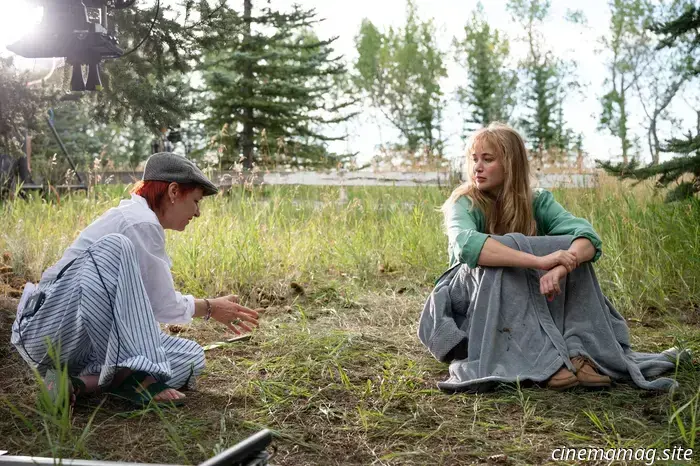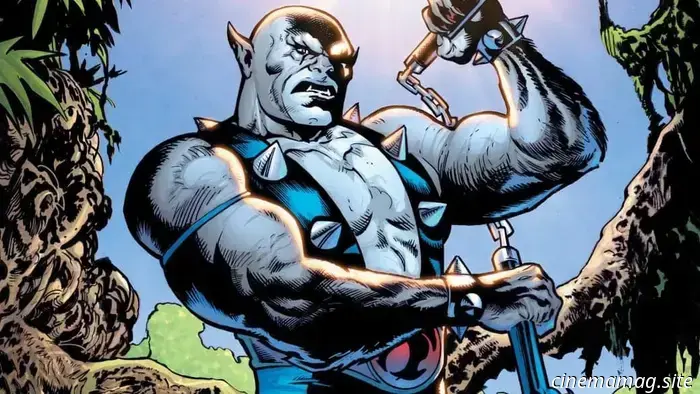
“Allow the Location to Communicate”: Lynne Ramsay Discusses Die My Love, Filming with Academy Ratio, and Adapting Challenging Novels.
Scottish writer-director Lynne Ramsay makes her return to feature filmmaking with Die My Love, eight years after You Were Never Really Here. This psychological drama features Jennifer Lawrence and Robert Pattinson as Grace and Jackson, a young couple with a newborn whose relocation from the city to rural Montana triggers a profound unraveling for Grace. Teaming up once more with cinematographer Seamus McGarvey, who worked with her on 2011's We Need to Talk About Kevin, Die My Love prioritizes an exploration of the human condition through a raw and visceral cinematic language rather than delving deeply into Grace's behavior. Ramsay employs the vivid Kodak Ektrachrome color reversal film stock she first used on Morvern Callar, combined with the Academy ratio to enhance the portrait-like quality of this character study.
I had a conversation with Ramsay over Zoom, where she shared her thoughts on her preference for adapting challenging novels, how the house influenced the aspect ratio and the opening shot, as well as the creative use of reversal film stock for the “day for night” sequences, which contributed a dreamy quality to the nighttime settings.
The Film Stage: You’ve adapted literature before, but this script involved two other screenwriters. What is your general approach to adaptations, and how did this one differ?
Lynne Ramsay: I prefer to build off an intriguing concept from a book rather than adhering too closely to the original material. The book is quite surreal, making it difficult to decipher what is real or imagined; it also switches between different narrators. Grace is portrayed as almost animalistic, and I was fascinated by her irreverence and unapologetic nature—this became my starting point. The adaptation process was particularly challenging, akin to my experience with [We Need to Talk About] Kevin, which was complex due to its literary format that included letters. It took me time to navigate my way into it.
During that period, I was also focused on a different project called Stone Mattress, based on a Margaret Atwood story, which I still hope to bring to life. I collaborated with Enda Walsh for about three or four weeks, after which he drafted a version, and I took it from there. Alice Birch joined in because we had only four weeks of preparation for this film, which required me to make changes without sufficient time. I had a lot to accomplish—this was the least amount of prep I've ever had. I would share ideas with her, and she would write them down. Typically, I either co-write or handle it solo, but this was dictated by the circumstances.
You mentioned this is a love story, and it might be useful to depict their relationship before having the baby. The non-linear structure reveals how much their lives have changed. Was that aspect present in the novel, or did it emerge during your writing process?
A significant portion of that development occurred during writing. The script described the house as one enters through a forest, into a field, and then sees the house—it was all very linear. I proposed approaching it from the house's perspective. I envisioned a long take allowing their emotions to unfold dramatically. The house had a maze-like quality due to the door placements, which influenced my structural choices. Upon seeing the house, I thought it would be interesting to depict their lives before the baby, when they first moved in.
Locations have a way of communicating their possibilities. I often find that what's in the script doesn't compare to what the location offers; sometimes it's simpler or far more compelling. It’s unconventional to start a film without first showing the exterior before delving into the interior. Ideas arise when you allow the location to speak for itself.
Do you implement specific practices during production, such as working with a small crew or familiar collaborators, to foster an environment that allows for changes to the script? How do you create this flexibility?
I wasn't frequently altering things on the fly, although there were moments when I realized something was better than my initial ideas and opted to adjust accordingly. Those moments are fantastic. There's also the challenge of limited daylight, raising concerns about finishing the day's shoot. Sometimes an insight emerges that surpasses the original script. However, it was primarily during the preparatory phase that concepts began to take shape. The location influenced my thoughts on how to start the story and how her pre-baby experience played a role. There's a sense of hope as they inherit the house; despite its imperfections, it belongs to them in a quirky way. I also show snippets of their past, where life was more vibrant before chaos ensued.
I find the house charming in its dilapidated state. When he paints it and fixes it at the end, it seems a bit off.
I believe it feels off to Grace. He’s putting forth great effort to improve it, yet she feels somewhat erased from her own space, as if questioning her existence there.
Discuss your collaboration with DP Seamus McGarvey again. You shot on


Other articles
 IFC Films has released the trailer for the thriller The Plague, featuring Joel Edgerton.
IFC Films has unveiled a trailer for The Plague, the forthcoming thriller by writer-director Charlie Polinger. The story follows a socially anxious 12-year-old who becomes the focus of a harsh tradition at a w...
IFC Films has released the trailer for the thriller The Plague, featuring Joel Edgerton.
IFC Films has unveiled a trailer for The Plague, the forthcoming thriller by writer-director Charlie Polinger. The story follows a socially anxious 12-year-old who becomes the focus of a harsh tradition at a w...
 Comic Book Sneak Peek – ThunderCats: Panthro #1
Dynamite Entertainment is set to release the one-shot comic ThunderCats: Panthro #1 on Wednesday, and we have the official preview of the issue for you below… In a solo adventure outside the limits of…
Comic Book Sneak Peek – ThunderCats: Panthro #1
Dynamite Entertainment is set to release the one-shot comic ThunderCats: Panthro #1 on Wednesday, and we have the official preview of the issue for you below… In a solo adventure outside the limits of…
 Hazbin Hotel Temporada 2 Episodio 4 Reseña – ‘Es un trato’
Ricky Church assesses the fourth episode of season 2 of Hazbin Hotel… At last, after being in the background for three episodes and displaying a sour demeanor, Alastor steps into the spotlight in ‘It’s a Dea…
Hazbin Hotel Temporada 2 Episodio 4 Reseña – ‘Es un trato’
Ricky Church assesses the fourth episode of season 2 of Hazbin Hotel… At last, after being in the background for three episodes and displaying a sour demeanor, Alastor steps into the spotlight in ‘It’s a Dea…
“Allow the Location to Communicate”: Lynne Ramsay Discusses Die My Love, Filming with Academy Ratio, and Adapting Challenging Novels.
Scottish writer-director Lynne Ramsay makes her return to feature films with Die My Love, eight years following You Were Never Really Here. This psychological drama features Jennifer Lawrence and Robert Pattinson in the roles of Grace and Jackson, a young couple with a newborn whose relocation from the city to rural Montana triggers a profound breakdown for Grace. Collaborating with
